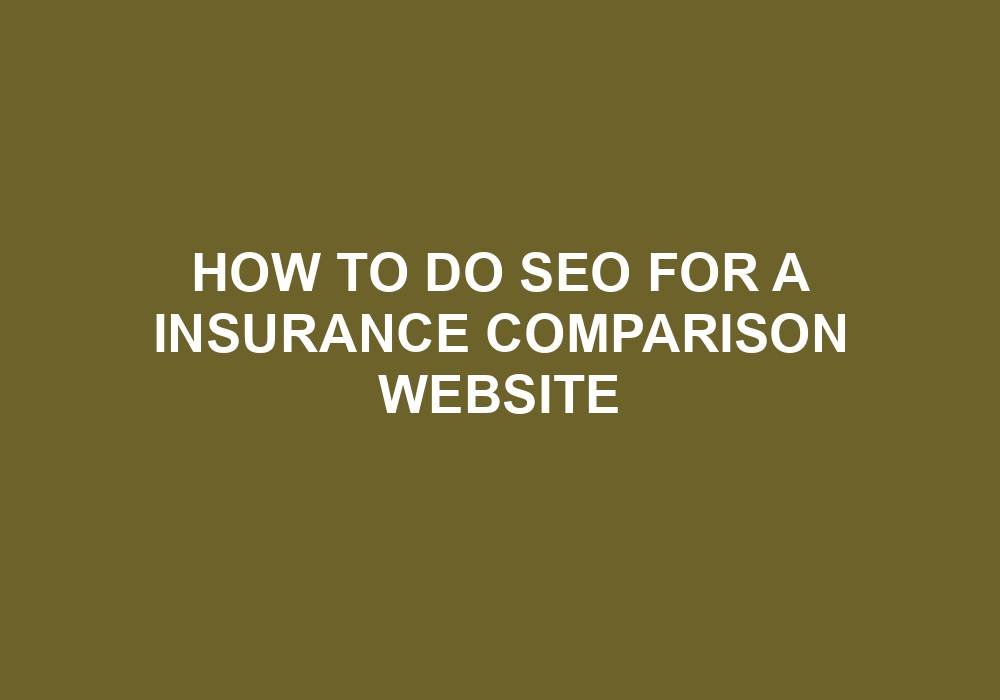In today’s digital age, having a strong online presence is crucial for businesses across all industries. For insurance comparison websites, the competition is fierce, and standing out from the crowd can be a daunting task. This is where search engine optimization (SEO) comes into play. By implementing effective SEO strategies, insurance comparison websites can not only increase their visibility on search engine results pages but also attract a targeted audience and drive organic traffic to their site.
SEO for insurance comparison websites involves a unique set of considerations and techniques. From optimizing website content and meta tags to building quality backlinks and improving site speed, there are various aspects to consider when aiming to rank higher on search engine results pages. In this guide, we will delve into the world of SEO for insurance comparison websites, exploring the best practices and strategies that can help your site rise above the competition. Whether you are a seasoned SEO professional or just starting out, this comprehensive guide will equip you with the tools and knowledge needed to navigate the ever-evolving landscape of search engine optimization in the insurance industry. So, let’s dive in and unlock the secrets to success in the world of SEO for insurance comparison websites!
- Perform keyword research to identify relevant search terms.
- Create high-quality, informative content related to insurance comparison.
- Optimize page titles, meta descriptions, and URLs with target keywords.
- Build backlinks from reputable websites in the insurance industry.
- Use structured data markup to enhance search engine visibility.
- Regularly update and maintain your website to keep it fresh and relevant.
How to Do SEO for an Insurance Comparison Website
If you have an insurance comparison website and want to improve its visibility and organic traffic, implementing effective search engine optimization (SEO) strategies is crucial. With the right approach, you can ensure that your website ranks higher in search engine results pages (SERPs), attracting more visitors and potential customers. In this article, we will guide you through the step-by-step process of optimizing your insurance comparison website for SEO success.
1. Conduct Keyword Research
The first step in optimizing your insurance comparison website is to conduct thorough keyword research. Identify the keywords and phrases that are relevant to your website’s content and your target audience’s search queries. Use keyword research tools like Google Keyword Planner or SEMrush to find high-volume, low-competition keywords that you can incorporate into your website’s content.
Once you have a list of keywords, strategically integrate them into your website’s meta tags, headers, titles, URLs, and content. Ensure that the keywords appear naturally and do not disrupt the readability and flow of your content.
2. Optimize On-Page Elements
Optimizing your website’s on-page elements is crucial for SEO success. Start by optimizing your website’s title tags and meta descriptions. Make sure they accurately describe your website and its content while incorporating relevant keywords. These elements appear in search engine results and can significantly impact click-through rates.
Next, optimize your website’s headers (H1, H2, H3, etc.) by incorporating keywords and structuring them hierarchically. This helps search engines understand the organization and relevancy of your content. Additionally, optimize your website’s URLs by making them concise, descriptive, and keyword-rich.
3. Create High-Quality Content
Creating high-quality, informative, and engaging content is crucial for SEO. Develop content that addresses the needs and queries of your target audience. Write blog posts, articles, or guides that provide valuable insights, tips, and advice related to insurance comparison.
Ensure that your content is well-structured, easy to read, and includes relevant keywords naturally. Incorporate multimedia elements, such as images, videos, or infographics, to enhance the visual appeal and engagement of your content. Regularly update and add fresh content to your website to keep it relevant and attract search engine crawlers.
4. Build High-Quality Backlinks
Building high-quality backlinks is essential for SEO success. Seek opportunities to collaborate with reputable websites, such as insurance blogs, industry publications, or authoritative websites, to earn backlinks. Guest posting, creating shareable content, or participating in industry forums and discussions can help you acquire valuable backlinks.
Additionally, ensure that your website’s internal linking structure is well-optimized. Link relevant pages within your website to provide users with a seamless navigation experience and help search engines understand the relationships between different pages of your website.
5. Monitor and Analyze Performance
Regularly monitor and analyze the performance of your insurance comparison website using tools like Google Analytics or SEMrush. Track important metrics such as organic traffic, bounce rate, average session duration, and conversion rates. Analyze the data to identify areas of improvement and adjust your SEO strategies accordingly.
Stay updated with the latest SEO trends, algorithm updates, and industry best practices to ensure that your website remains optimized for search engines. Continuously refine and adapt your SEO strategies to maintain a competitive edge in the ever-evolving digital landscape.
6. Ensure Mobile-Friendliness
In today’s mobile-dominated world, ensuring that your insurance comparison website is mobile-friendly is crucial. Optimize your website’s design and layout for mobile devices, ensuring fast loading times, responsive design, and easy navigation. Mobile-friendly websites are favored by search engines and provide a better user experience, ultimately boosting your SEO efforts.
In conclusion, implementing effective SEO strategies is essential for improving the visibility and organic traffic of your insurance comparison website. By conducting keyword research, optimizing on-page elements, creating high-quality content, building high-quality backlinks, monitoring performance, and ensuring mobile-friendliness, you can enhance your website’s search engine rankings and attract more visitors and potential customers.
Frequently Asked Questions
Here are some commonly asked questions about how to do SEO for an insurance comparison website:
What is SEO and why is it important for an insurance comparison website?
SEO stands for Search Engine Optimization, which is the practice of optimizing a website to improve its visibility and ranking in search engine results pages. For an insurance comparison website, SEO is crucial as it helps drive organic traffic and increase the chances of attracting potential customers. With effective SEO strategies, the website can appear higher in search engine results, making it more likely for users to find and use the platform.
Implementing SEO techniques such as keyword research, on-page optimization, and link building can lead to better visibility and higher rankings, ultimately resulting in increased website traffic and potential conversions.
How can I conduct keyword research for my insurance comparison website?
Keyword research is an essential aspect of SEO for an insurance comparison website. To begin, you can make use of keyword research tools like Google Keyword Planner or SEMrush to identify relevant keywords and phrases related to insurance comparison. It’s important to target keywords that have a high search volume and are relevant to your website’s content and offerings.
Once you have identified a list of potential keywords, you can analyze their competition and search volume. Focus on long-tail keywords that are specific to insurance comparison, as they have a higher chance of attracting targeted traffic. Incorporate these keywords naturally into your website’s content, meta tags, headers, and URLs for optimal SEO performance.
What are some on-page optimization techniques I should implement for my insurance comparison website?
On-page optimization is crucial for ensuring that your insurance comparison website is easily discoverable by search engines. Some important on-page optimization techniques include:
– Creating unique and compelling meta tags, including title tags and meta descriptions, that accurately describe the content of each page.
– Optimizing your website’s headings (H1, H2, H3, etc.) to provide a clear hierarchy of information.
– Writing high-quality, informative, and keyword-rich content that is valuable to your target audience.
– Incorporating relevant keywords naturally throughout your content, including in headings, subheadings, and body text.
– Optimizing your website’s URLs, ensuring they are short, descriptive, and include target keywords.
By implementing these on-page optimization techniques, you can improve your website’s visibility and increase the likelihood of attracting organic traffic.
How can I build high-quality backlinks for my insurance comparison website?
Building high-quality backlinks is an important off-page SEO technique that can significantly impact the visibility and authority of your insurance comparison website. Here are some strategies you can use:
– Guest blogging: Reach out to relevant websites or blogs in the insurance industry and offer to write guest posts. In return, you can include a backlink to your website within the content or author bio.
– Online directories: Submit your website to reputable online directories that are relevant to the insurance industry. This can help improve your website’s visibility and generate valuable backlinks.
– Influencer outreach: Identify influencers or industry experts in the insurance field and establish relationships with them. They may be willing to share your content or link to your website, providing valuable backlinks.
– Content promotion: Create high-quality, shareable content that offers value to your target audience. Promote this content through social media channels, email newsletters, and other relevant platforms to attract natural backlinks.
Remember, the key is to focus on building high-quality backlinks from authoritative sources, as this can greatly enhance your website’s SEO performance.
How can I track the SEO performance of my insurance comparison website?
Tracking the SEO performance of your insurance comparison website is essential to understand the effectiveness of your strategies and identify areas for improvement. Here are some tools and techniques you can use:
– Google Analytics: Set up Google Analytics to monitor website traffic, user behavior, and conversions. This will provide valuable insights into the effectiveness of your SEO efforts.
– Google Search Console: Utilize Google Search Console to monitor your website’s indexing status, search performance, and receive alerts about potential issues or penalties.
– Rank tracking tools: Use rank tracking tools like SEMrush or Ahrefs to monitor your website’s keyword rankings and visibility in search engine results.
– Backlink analysis tools: Regularly analyze your website’s backlink profile using tools like Majestic or Moz to ensure the quality and relevance of your backlinks.
By regularly monitoring and analyzing these metrics, you can make data-driven decisions to improve the SEO performance of your insurance comparison website.
In conclusion, implementing effective SEO strategies for an insurance comparison website is crucial for its success in the competitive online landscape. By following the steps outlined in this guide, website owners can optimize their content, improve their search engine visibility, and attract a larger audience. From conducting thorough keyword research to creating high-quality and relevant content, every aspect of SEO plays a significant role in enhancing the website’s ranking and driving organic traffic.
Moreover, staying up-to-date with the latest SEO trends and algorithms is equally important. As search engines constantly evolve, website owners must adapt their SEO strategies accordingly to maintain their competitive edge. Regularly monitoring and analyzing website performance, making necessary adjustments, and seeking professional guidance when needed will ensure long-term success in optimizing an insurance comparison website for search engines.
By implementing these SEO techniques and staying committed to continuous improvement, website owners can position their insurance comparison websites for long-term success and establish themselves as trusted sources in the industry. The efforts put into optimizing the website’s content, structure, and overall user experience will ultimately pay off in increased organic traffic, higher conversion rates, and improved overall performance. So, get ready to embark on the SEO journey and witness the positive impact it can have on your insurance comparison website.





